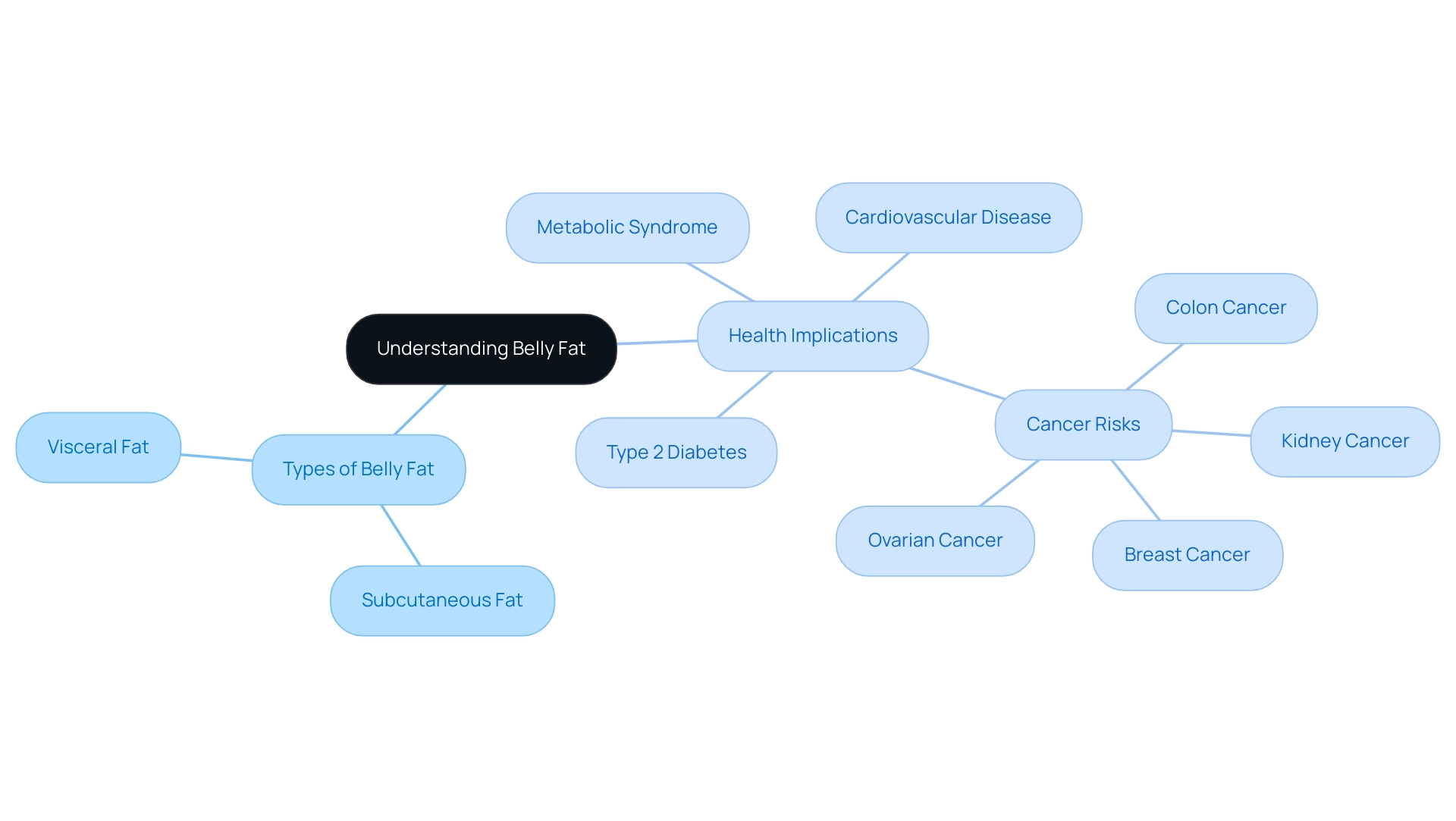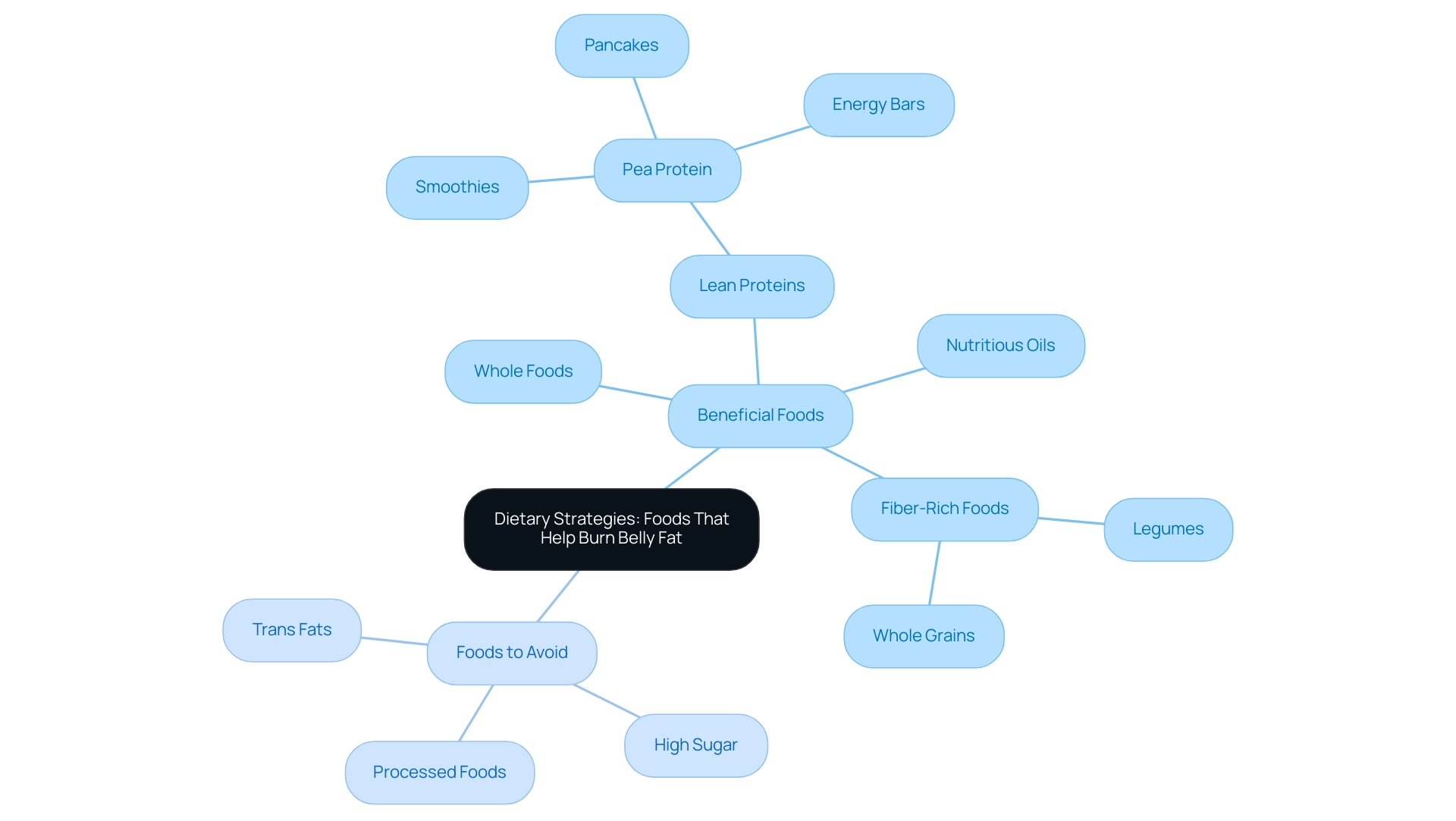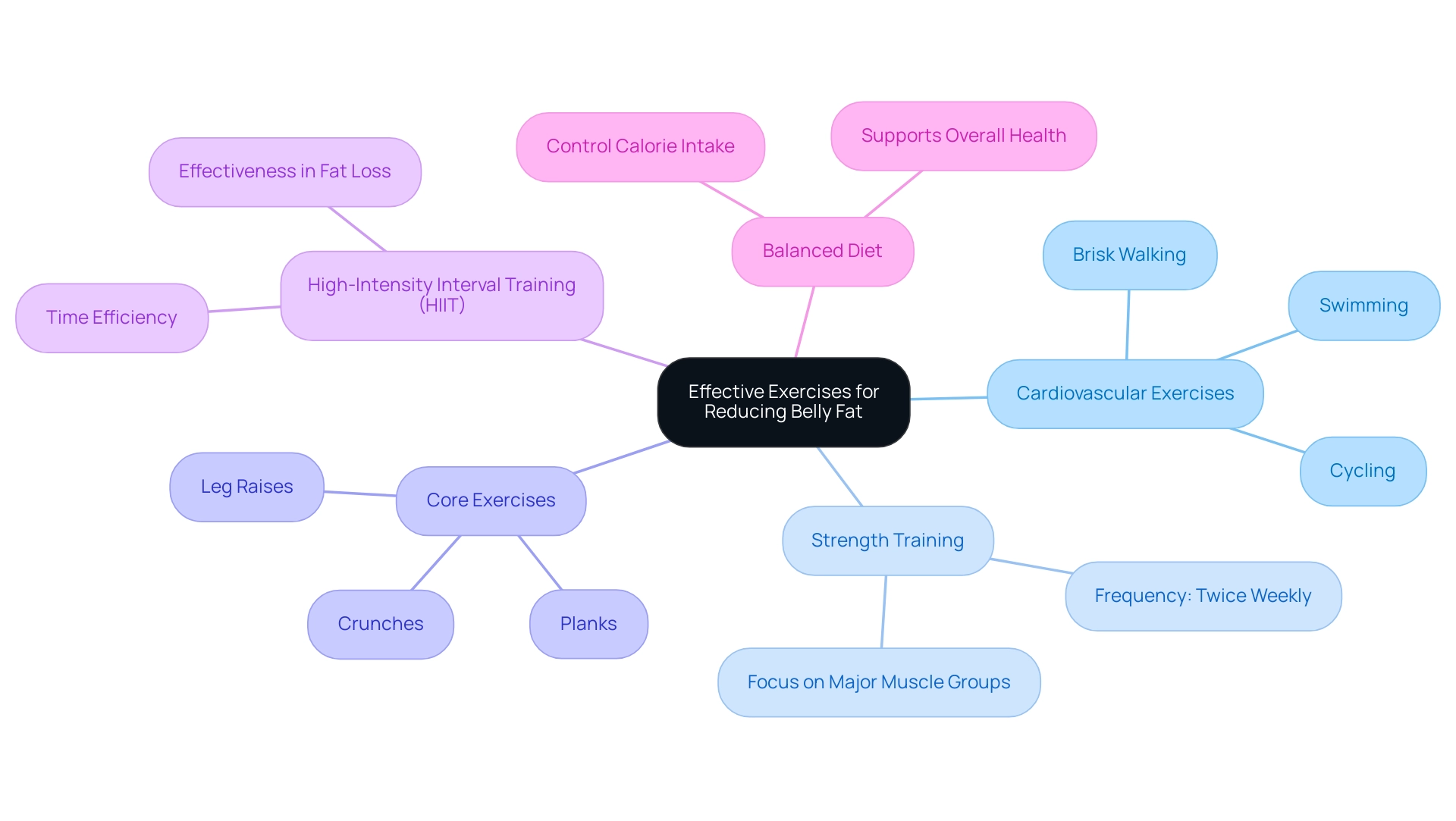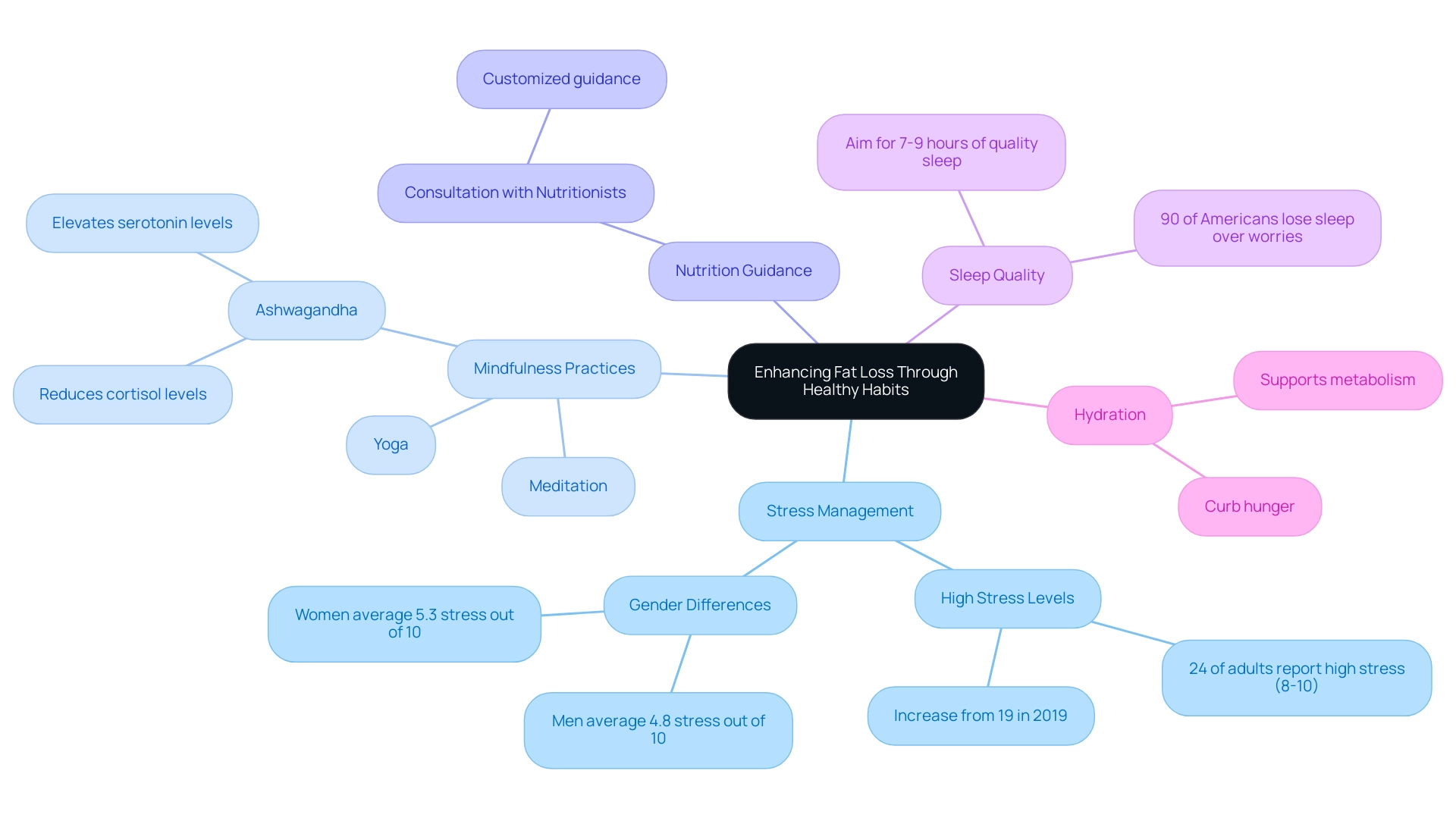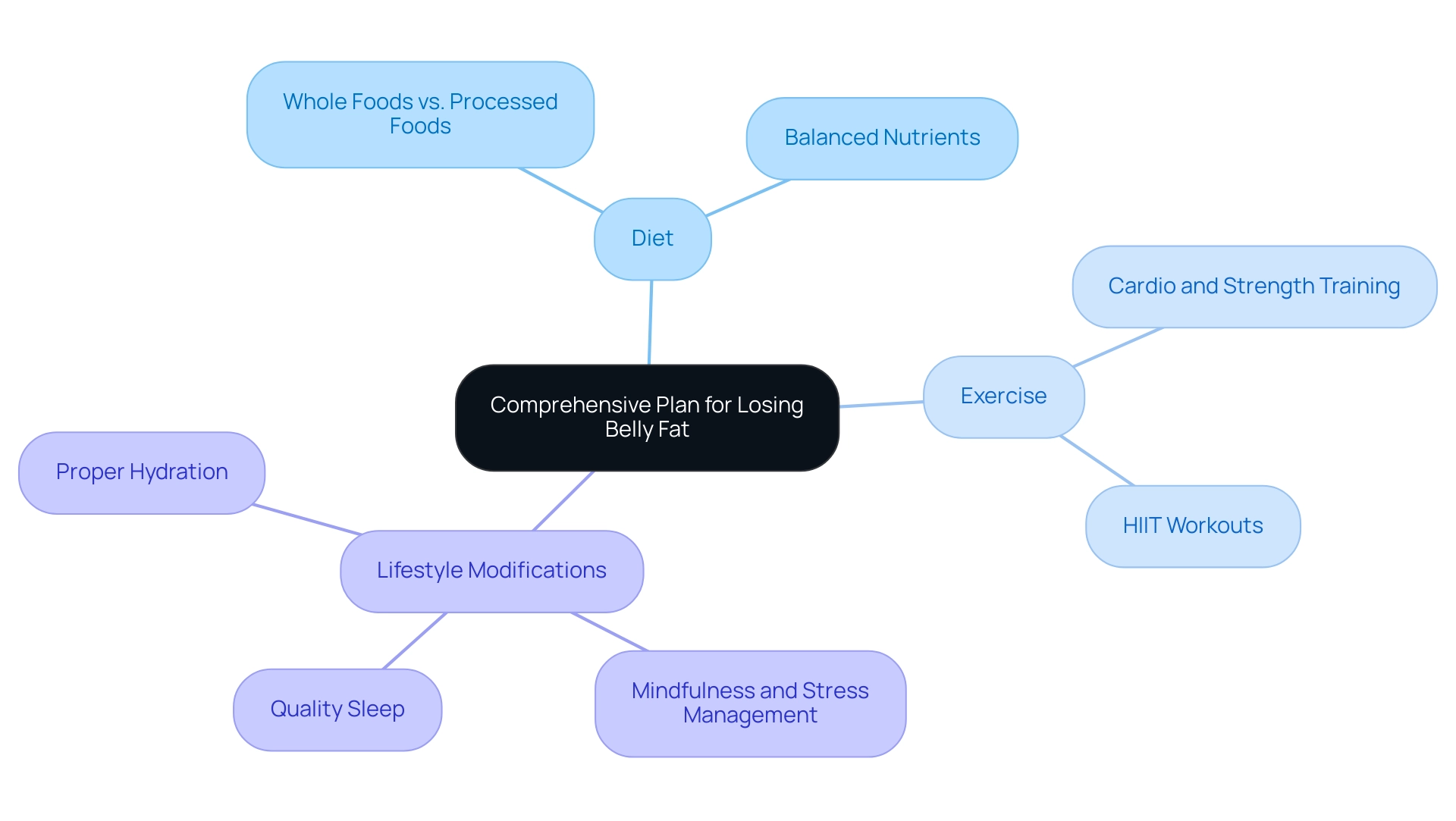Introduction
Belly fat is more than just a cosmetic concern; it poses serious health risks that can impact overall well-being. This article delves into the two primary types of belly fat—subcutaneous and visceral—and their implications for health, including links to chronic diseases such as cardiovascular issues and diabetes.
It highlights the importance of understanding these risks as a catalyst for lifestyle changes that promote better health outcomes. Readers will discover effective dietary strategies, exercise regimens, and lifestyle modifications designed to combat abdominal fat.
By implementing these comprehensive approaches, individuals can not only reduce belly fat but also enhance their overall health and quality of life.
1. Understanding Belly Fat: Types and Health Implications
Belly fat is primarily categorized into two distinct types:
- Subcutaneous fat, which resides directly beneath the skin
- Visceral fat, which encases internal organs
Visceral fat is particularly alarming due to its strong association with a range of medical complications, including:
- Cardiovascular disease
- Type 2 diabetes
- Metabolic syndrome
Recent studies underscore that adults who manage to maintain lower weight gains as they age experience significantly reduced risks of various cancers, such as:
- Colon cancer
- Kidney cancer
- Breast cancer
- Ovarian cancer
This statistic emphasizes the long-term wellness implications of understanding how to lose belly fat. For instance, the accumulation of visceral fat is not merely an aesthetic concern; it produces harmful cytokines and other molecules that can negatively impact overall well-being, fostering chronic diseases. The article titled 'Risks of Visceral Fat' explains how women, as they age, tend to accumulate more visceral fat, which can lead to increased waistlines even without weight gain, further linking visceral fat to serious risks.
Additionally, obesity can exacerbate conditions like asthma, complicating management and worsening symptoms. Health professionals, including Dr. James de Lemos, emphasize the necessity of exploring hormonal modifications to better control fat distribution in the abdominal region. By recognizing the dangers associated with excess belly fat, individuals are more likely to commit to essential lifestyle changes that can teach them how to lose belly fat and lead to improved health outcomes.
2. Dietary Strategies: Foods That Help Burn Belly Fat
To effectively understand how to lose belly fat, it is essential to incorporate foods that facilitate fat burning into your daily diet. Highlighting whole foods like fruits, vegetables, whole grains, lean proteins—including the beneficial choice of pea protein—and nutritious oils is essential. Pea protein not only supports muscle maintenance but also offers cardiovascular benefits, making it an excellent addition to a balanced diet.
For instance, you can try adding pea protein powder to:
- Smoothies
- Pancakes
- Energy bars
for a nutritious boost. Foods rich in fiber, such as legumes and whole grains, play a vital role in improving sensations of fullness, which can assist in managing body mass. Furthermore, nutritious oils sourced from avocados and nuts can significantly enhance satiety and support overall metabolic health.
Conversely, it is advisable to avoid processed foods that are high in sugar and trans fats, as these are known contributors to gaining mass and the accumulation of belly fat. With recent statistics indicating that more than 11.5% of women and 6.9% of men are affected by
severe obesity, it underscores the necessity of adopting healthier eating habits to combat this trend. The National Institute of Diabetes and Digestive and Kidney Diseases emphasizes that a balanced diet is crucial for effective weight management.
Moreover, although high-protein diets can be advantageous, many Americans consume 90% more protein than required, which raises concerns regarding their implications. Understanding the right balance of macronutrients is essential in crafting an effective dietary strategy on how to lose belly fat. By incorporating pea protein into your meals, you not only boost your protein consumption but also gain from its anti-cancer characteristics and support for cardiovascular well-being.
3. Effective Exercises for Reducing Belly Fat
To effectively understand how to lose belly fat, it is vital to incorporate both cardiovascular and strength training exercises into your fitness routine. The current recommendation is to engage in at least 150 minutes of moderate-intensity aerobic activity each week, which can include exercises such as brisk walking, cycling, or swimming. Complementing this, strength training should be performed at least twice weekly, focusing on all major muscle groups to enhance overall body composition.
Recommended exercises for learning how to lose belly fat include:
- Planks
- Crunches
- Leg raises
All of which contribute to core strength development. High-Intensity Interval Training (HIIT) has gained attention for its effectiveness in burning calories and improving metabolic rate. This training method consists of alternating short bursts of intense exercise with recovery periods, making it a time-efficient option for fat loss. According to recent statistics, HIIT workouts have been shown to provide significant reductions in belly fat, making them an effective method for those seeking to understand how to lose belly fat, as confirmed by fitness experts.
Notably, studies reveal that relative mass loss can reach:
- 11.8% in males
- 10.3% in females
Through these exercise strategies, highlighting their effectiveness.
Furthermore, it's essential to maintain a balanced diet to control calorie intake, which is crucial for fat loss. A balanced diet complements the exercise regimen and supports overall health. The case study titled '
Control of Energy Expenditure in Humans' sheds light on how energy expenditure is regulated and its implications for managing body mass, reinforcing the need for a comprehensive approach that includes both diet and exercise.
Edward R. Laskowski succinctly summarizes the crux of fitness:
What's most important is making regular physical activity part of your lifestyle.
By adhering to these guidelines, individuals can create a balanced exercise regimen that demonstrates how to lose belly fat effectively.
4. Lifestyle Changes: Enhancing Fat Loss Through Healthy Habits
To effectively enhance fat loss, it is essential to understand how to lose belly fat by implementing several key lifestyle changes. Handling tension is vital, as
elevated pressure can greatly lead to an increase in mass, particularly in the abdominal area. Recent statistics indicate that 24% of adults assessed their average pressure between eight and 10, an increase from 19% in 2019, emphasizing the rising occurrence of high tension levels and its effect on gaining mass.
Mindfulness practices like meditation and yoga have been demonstrated to reduce stress, providing a helpful method for those looking to control their body. Furthermore, incorporating assistance from certified nutritionists at Awesome Health Club can offer customized guidance suited to personal requirements, improving overall wellness and management. Schedule your free consultation today to start your journey towards better health.
Furthermore, the herb ashwagandha has been recognized for its capacity to encourage a calm state, lessening anxiety and tension, which may further aid in managing body composition efforts. Ashwagandha functions by reducing cortisol levels, which are associated with stress and gain, while also elevating serotonin levels that enhance feelings of well-being. Furthermore, sleep quality plays a vital role in managing body mass.
Research indicates that poor sleep is associated with increased appetite and weight gain; therefore, aiming for 7-9 hours of quality sleep per night is advisable. Alarmingly, nearly 90% of Americans report losing sleep due to concerns about well-being and the economy, underscoring the urgency of addressing sleep quality in the context of fat loss. Staying well-hydrated is another fundamental aspect; drinking sufficient water throughout the day not only supports metabolism but also helps curb hunger.
Additionally, a case study found that women reported higher stress levels than men, averaging 5.3 out of 10 compared to 4.8, indicating that stress can affect different demographics in unique ways. By integrating these healthy habits into your daily routine, alongside insights from certified nutritionists, you can foster an environment that teaches you how to lose belly fat. As mentioned by Julia Mueller, lead researcher from the University of Cambridge’s Medical Research Council, monitoring and addressing depressive symptoms can aid in preventing further weight gain, ultimately benefiting both mental and physical well-being.
With the rising concerns about well-being and economic stability—reflected in the fact that nearly 90% of Americans report losing sleep over these worries—adopting these lifestyle changes is more pertinent than ever.
5. Putting It All Together: A Comprehensive Plan for Losing Belly Fat
Successfully learning how to lose belly fat requires a multifaceted approach that incorporates diet, exercise, and lifestyle modifications. Begin by differentiating between the various types of belly fat, as understanding their health implications is crucial for effective management. Embrace a balanced diet centered around whole foods, consciously avoiding processed options that can hinder progress.
Regular physical activity is essential; to understand how to lose belly fat, aim to include both cardiovascular exercises and strength training in your routine, as muscle tissue burns more calories at rest compared to fat tissue, thereby increasing your resting metabolic rate. Moreover, lifestyle adjustments like managing tension, ensuring quality sleep, and maintaining proper hydration are essential to support your fat loss efforts. As Jane Doe, a fitness guru, states,
To maximize belly fat loss, integrate HIIT workouts into a well-rounded fitness regimen that includes strength training and flexibility exercises.
Consistency and intensity are key to seeing results. Incorporating mindfulness practices can also be beneficial; they have been shown to help manage emotional eating—often driven by stress rather than true hunger. This awareness enables individuals to make more intentional food choices, fostering a healthier relationship with food.
Research indicates that mindfulness can significantly
reduce emotional eating, promoting healthier eating habits that are essential for learning how to lose belly fat. As you apply these strategies, develop a thorough plan to not only target belly fat but also improve overall well-being. Regularly track your progress and refine your approach as necessary to ensure you remain aligned with your health goals.
Conclusion
Reducing belly fat is a critical endeavor that goes beyond aesthetics, significantly impacting overall health and well-being. This article has explored the two primary types of belly fat—subcutaneous and visceral—and their serious health implications, including links to chronic diseases like cardiovascular issues and diabetes. Understanding these risks is the first step in motivating individuals to make necessary lifestyle changes.
Implementing dietary strategies is essential in combating belly fat. Emphasizing whole foods, such as fruits, vegetables, lean proteins, and healthy fats, can facilitate fat burning and improve satiety. Avoiding processed foods high in sugar and trans fats is equally important for effective weight management. Coupled with a balanced diet, regular physical activity—including cardiovascular and strength training—forms the backbone of a successful fat loss strategy. High-Intensity Interval Training (HIIT) has emerged as a particularly effective method for burning calories and reducing abdominal fat.
Furthermore, lifestyle modifications play a crucial role in supporting fat loss efforts. Managing stress through mindfulness practices, ensuring adequate sleep, and maintaining proper hydration can enhance metabolic health and aid in weight management. By adopting these healthy habits and integrating them into daily routines, individuals can create an environment conducive to fat loss.
Ultimately, achieving a healthier body requires a comprehensive approach that combines diet, exercise, and lifestyle changes. By understanding the types of belly fat and their health implications, individuals can take informed steps toward reducing abdominal fat and improving their overall quality of life. The journey may be challenging, but the rewards of enhanced health and well-being are well worth the effort.
